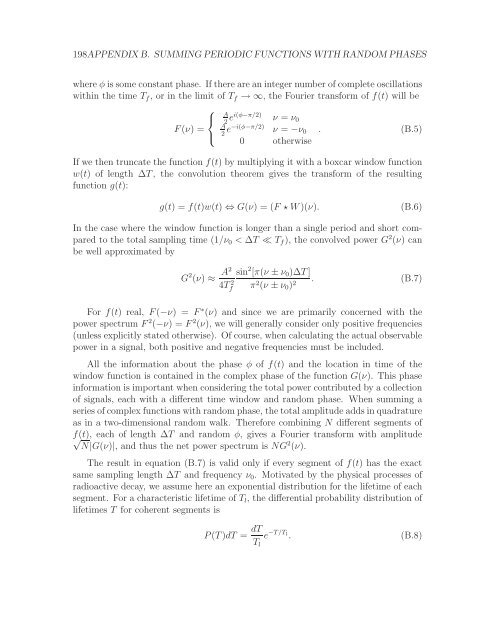Radiation Transport Around Kerr Black Holes Jeremy David ...
Radiation Transport Around Kerr Black Holes Jeremy David ...
Radiation Transport Around Kerr Black Holes Jeremy David ...
You also want an ePaper? Increase the reach of your titles
YUMPU automatically turns print PDFs into web optimized ePapers that Google loves.
198APPENDIX B. SUMMING PERIODIC FUNCTIONS WITH RANDOM PHASES<br />
where φ is some constant phase. If there are an integer number of complete oscillations<br />
within the time T f , or in the limit of T f → ∞, the Fourier transform of f(t) will be<br />
⎧<br />
A<br />
⎨<br />
2 ei(φ−π/2) ν = ν 0<br />
A<br />
F(ν) =<br />
⎩<br />
2 e−i(φ−π/2) ν = −ν 0 . (B.5)<br />
0 otherwise<br />
If we then truncate the function f(t) by multiplying it with a boxcar window function<br />
w(t) of length ∆T, the convolution theorem gives the transform of the resulting<br />
function g(t):<br />
g(t) = f(t)w(t) ⇔ G(ν) = (F ⋆ W)(ν).<br />
(B.6)<br />
In the case where the window function is longer than a single period and short compared<br />
to the total sampling time (1/ν 0 < ∆T ≪ T f ), the convolved power G 2 (ν) can<br />
be well approximated by<br />
G 2 (ν) ≈ A2<br />
4T 2 f<br />
sin 2 [π(ν ± ν 0 )∆T]<br />
π 2 (ν ± ν 0 ) 2 . (B.7)<br />
For f(t) real, F(−ν) = F ∗ (ν) and since we are primarily concerned with the<br />
power spectrum F 2 (−ν) = F 2 (ν), we will generally consider only positive frequencies<br />
(unless explicitly stated otherwise). Of course, when calculating the actual observable<br />
power in a signal, both positive and negative frequencies must be included.<br />
All the information about the phase φ of f(t) and the location in time of the<br />
window function is contained in the complex phase of the function G(ν). This phase<br />
information is important when considering the total power contributed by a collection<br />
of signals, each with a different time window and random phase. When summing a<br />
series of complex functions with random phase, the total amplitude adds in quadrature<br />
as in a two-dimensional random walk. Therefore combining N different segments of<br />
f(t), each of length ∆T and random φ, gives a Fourier transform with amplitude<br />
√<br />
N|G(ν)|, and thus the net power spectrum is NG 2 (ν).<br />
The result in equation (B.7) is valid only if every segment of f(t) has the exact<br />
same sampling length ∆T and frequency ν 0 . Motivated by the physical processes of<br />
radioactive decay, we assume here an exponential distribution for the lifetime of each<br />
segment. For a characteristic lifetime of T l , the differential probability distribution of<br />
lifetimes T for coherent segments is<br />
P(T)dT = dT<br />
T l<br />
e −T/T l<br />
.<br />
(B.8)
















